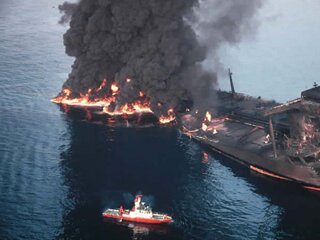HAVEN, Italy, 1991
11 April 1991

Incident
On 11th April 1991 the very large crude carrier HAVEN, with 144,000 tonnes of Iranian heavy crude oil onboard, suffered an explosion while anchored in Genoa Roads. The explosion was caused reportedly by an electrical spark during tank cleaning and resulted in the loss of six crew members. The vessel broke into three sections with one section sinking close to the anchor location. The vessel drifted south-west where the bow section then sank. The remaining main section was towed towards Capo Arenzano, west of Genoa. Fire-fighting operations were initiated rapidly after the initial explosions, but were unable to extinguish the fires on board. As a consequence, the main section of the vessel sank approximately 1 ½ nautical miles offshore on 14th April following further explosions. The exact fate of the cargo is not known. However, estimates suggest approximately half of the oil onboard burnt during the explosions and fires. Over 10,000 tonnes of oil were estimated to have spilled prior to the sinking of the main section with further releases of oil for more than a year. The spilled oil initially spread widely along the north shores of the Ligurian Sea, resulting in heavy contamination of the Italian coastline, and to a lesser extent of French and Monaco shores. The wreck of the main section of HAVEN is now a noted diving location and artificial reef.
Response
After several attempts, divers were able to reduce the seepage from the main wreck about ten days after the sinking. This provided short-term respite for the coastal communities nearby, and paved the way for a comprehensive search of the wreck for any remaining oil. The response at sea also resulted in the collection of approximately 5,500m3 of oil. In an attempt to recover oil on water the authorities employed a number of workboats normally utilised to recover algae blooms from the water surface. These vessels have large inclined rotating belts forward and these were successful in recovering amounts of oil into onboard tanks. They were however limited to use in nearshore areas. Additionally, considerable lengths of boom were deployed in an attempt to protect the shoreline, and although successful initially, storms pushed oil onto the beaches eventually. Shoreline clean-up was undertaken primarily by volunteers and military personnel and involved mostly manual removal of oil and oiled debris.
The IOPC Funds note payments of 95.5 billion Lira were made to Italian claimants including fishermen and tourist businesses, as well as 23 million Francs to French claimants, primarily for clean-up. These figures include payments made by the P&I Club concerned.
ITOPF Involvement
ITOPF was mobilised to site during the response stage to provide technical advice.
References
- Hooke, N. (1997) Maritime casualties, 1963-1996. 2nd edition, LLP Limited, London
- Oil Spill Intelligence Report, 30 May 1991 & 6 June 1991
- Martinelli, M., Luise, A., Tromellini, E., Sauer, T.C., Neff, J.M. and Douglas, G.S. (1995) The M/C Haven oil spill: Environmental assessment of exposure pathways and resource injury. IOSC Papers.
Links
- CEDRE - HAVEN Spill Summary
- IOPC Funds. Reports of HAVEN incident are contained within the IOPC Fund annual reports from 1991 onwards.
Categories: Italy, Oil, Oil Tanker, Europe
